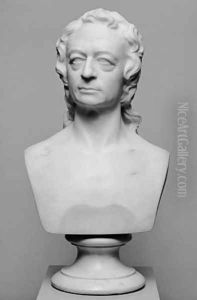Edward Augustus Brackett Paintings
Edward Augustus Brackett was an American sculptor known for his portrait busts and statues in the mid-19th century. Born on October 1, 1818, in Vassalboro, Maine, he was largely self-taught as an artist, which was not uncommon for the period. Brackett's early career saw him working in various materials, including marble, which became his preferred medium for his most notable works.
Brackett's sculptures often captured the likenesses of prominent figures of his time, including statesmen, writers, and abolitionists. He gained recognition for his portrait busts, which were praised for their lifelike qualities and depth of character. One of his most famous works is the bust of the writer and philosopher Henry David Thoreau. This particular bust is notable because it was created from life sittings, making it one of the most reliable representations of Thoreau's appearance.
In addition to his portrait busts, Brackett also created a number of statues and was involved in various public commissions. His interests were not limited to art alone; he was also an ardent abolitionist and involved in the social and political issues of his day. Brackett's life and work were influenced by the intellectual and cultural movements of the 19th century, including Transcendentalism, and he was part of the broader cultural milieu of New England that included figures such as Ralph Waldo Emerson and Nathaniel Hawthorne.
Edward Augustus Brackett's work has been displayed in various institutions, and his sculptures are part of the collections of museums, including the Massachusetts State House. He continued to sculpt and contribute to the American art scene until later in his life. Brackett passed away on April 5, 1908, in Winchester, Massachusetts, having left a legacy as a skilled portraitist who captured the essence of American cultural and political life during his era.
